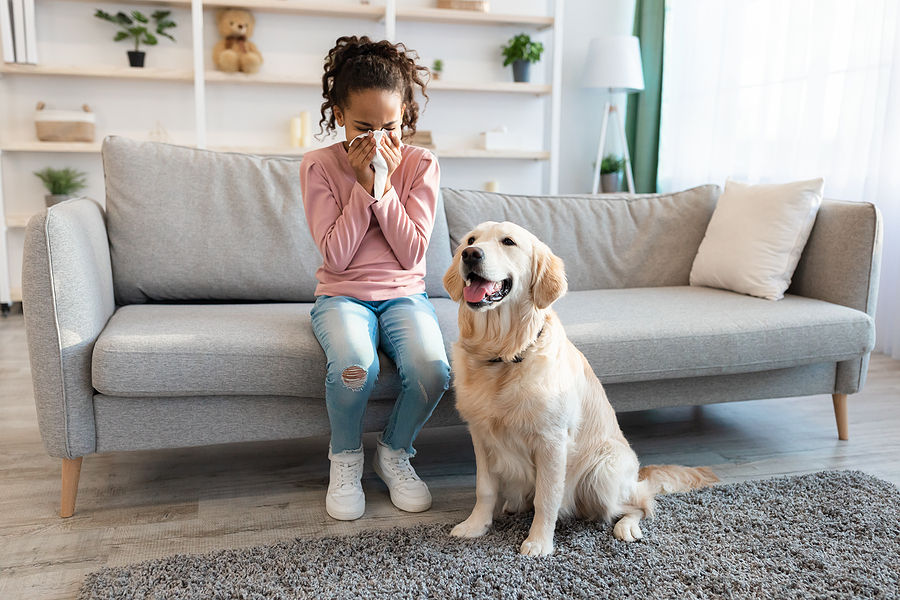Managing Pet Allergies: Tips for a Comfortable Home with Pets
Posted By:SSG Admin Posted On:05-Sep-2024
In the U.S., 70% of households have at least one pet. Meanwhile, upwards of 20% of the people in the world have pet allergies. Allergies to cats and dogs top the list of pet allergies, but there are also allergies to ferrets, hamsters, horses, rabbits, and so many others. These allergies are caused by a protein found in the dead skin cells, saliva, and urine of an animal.
What Are the Common Symptoms of Pet Allergies?
Pet allergies are very similar to other allergies like you’d experience with tree and weed pollen, and dust mites.
- Cough
- Hives
- Nasal congestion
- Red, itchy eyes
- Runny nose
- Sneezing
You might find that these symptoms keep you up or wake you up when you’re sleeping. Fatigue is possible. You might feel irritable because you’re uncomfortable. The other problem is the severity of the symptoms may be worse in some people and not that bad in others. Severe pet allergies can trigger allergy-related asthma in some, and that can be dangerous.
How do you make your home allergy-free without getting rid of all pets? You can’t stop neighbors from owning animals, and you’re going to encounter service animals when you’re out in public, so how can you keep yourself safe at home and when you’re out traveling or running errands?
How Do You Create an Allergy-Free Home?
What can you do to limit allergens in your house? Here are some of our top tips for allergy prevention.
Educate Anyone Living in the Home
If it’s your home and immediate family, it’s easier because they probably know about the severity of your pet allergy. If you share a home with renters or live in an apartment building where people have animals, they may not understand the severity of pet allergies. Educate them about the symptoms you experience and what happens if you are exposed to pet dander.
Not everyone will understand or care to help you out, but you might be surprised by how many are willing to do their part if it’s within reason. Most people will be okay keeping their dog from riding in the same elevator when you’re heading down to the lobby.
Create Pet-Free Zones
Set up a few pet-free zones for your comfort. Make a bathroom pet-free if possible. There should be a bedroom that pets aren’t allowed in. And, a den or office can be set up as a pet-free place for you to watch a movie or TV show, listen to music, or read a book.
Make sure you have an air purifier in this pet-free room. Also, add weatherstripping to the door and a door sweep to keep pet dander from coming in any gaps.
Clean Your Home Often
Keeping a clean home is important. You want to step up and complete household chores daily instead of once a week.
If someone in your home has pets, don’t immediately move to rehome the animal. Instead, get someone who doesn’t have allergies to vacuum every day using a vacuum with a HEPA filter. Wash carpets periodically.
You might find it’s better not to have carpets in your home. Get wood or vinyl plank flooring instead. If you have children who spend time on the floor, washable play rugs are an idea. Invest in a dust mop, such as a Swiffer, where you can clean and toss the pad away, or get one with washable pads that you can put in the wash immediately after cleaning.
Clean the floors each day to remove pet dander and fur and keep it from building up. Bedding, curtains, and lap blankets should be washed each week.
Invest in Air Purifiers
Have air purifiers that use HEPA filters and run them all day. Many energy-efficient models cost very little to run all day. A system with a washable filter reduces the cost of having to pay for new filters, too.
If you find one that also has UV lights and Ionizers it helps kill germs and odors. It’s worth investing in it if desired. Don’t skimp on this purchase either. It may be cheaper because it’s ineffective at cleaning the air of pet dander. Ask an allergy doctor for guidance in finding the best model.
Groom Your Pets
Limit pet dander by washing your pets regularly. If you can’t wash them in water due to their age, size, or health, a dry shampoo is a good secondary option. Or, bring them to a pet salon and let someone else do it.
When you brush your dog or cat, bring them outside, leashed if necessary. It’s better to remove the hair and dander outside. You can wear a mask while you do it to limit exposure while you’re brushing them.
What About When You’re Out in Public
People have service or therapy animals for several reasons, and not all will be visible to you at first glance. You may have seen videos on social media accusing people with diabetes, POTS, PTSD, or other conditions as having fake service animals. The dogs are essential and telling people to prove the dog is a service animal adds unnecessary stress.
Instead, be honest and explain you have pet allergies and cannot be near the dog. Someone with a service animal isn’t going to accuse you of lying. You can simply ask an employee to get what you need or get a time frame on how long the service dog will be in that area so that you have an idea of how long to go to another area.
If you’re on a flight, have an inhaler and medicine with you as a precaution and explain to the flight attendants that you have an allergy. If there’s another seat available or someone can switch with you, it’s better to ask and not be mean about it.
Seek Medical Treatment to End Pet Allergies
A clean home rid of pet dander and fur helps, but it’s not a guaranteed way to keep allergies at bay. You cannot stop others from owning pets or having necessary service animals. You can take steps to protect your health.
Use allergy medications to ease the symptoms. If you find that over-the-counter medications don’t help, ask an allergy specialist about prescription medications. If you do suffer from allergy-related asthma, make sure you have a prescription inhaler with you.
Allergy treatments are essential. Premium Allergy & Respiratory Center has better solutions to ease allergies to cats, dogs, and other pets. Allergy shots are two of the best solutions, but not everyone is comfortable with needles. Ask Dr. Sabry and her team of allergy specialists about needle-free immunotherapy.
Sublingual (SLIT) treatments involve drops or dissolvable tablets that you place under the tongue. Your first treatment is complete under a doctor’s observation to ensure the dose is correct. After that, you take the drops or tablets daily for years. This helps your body slowly adapt to exposure to the allergen, which stops the body’s allergic response.
Schedule an appointment with Dr. Sabry and her team to discuss your concerns. You can have the pet you and your family members have always wanted and not have to suffer in the process.





